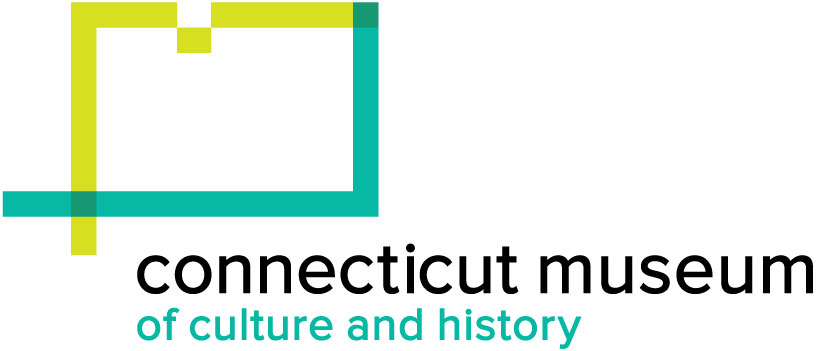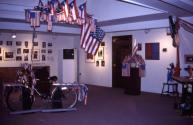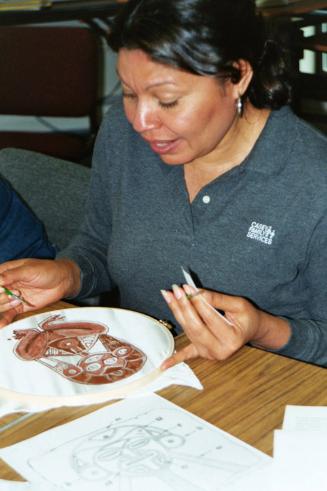¡Que Bonita Bandera! Exhibit Displays & Poetry Reading and Lao Multicultural Day
SubjectPortrait of
Ilka Robles
(Puerto Rican, born 1953)
SubjectPortrait of
Glaisma Pérez Silva
(Puerto Rican)
SubjectPortrait of
Isabel Osorio
(Puerto Rican)
SubjectPortrait of
Khamphone Phonekeo
(Laotian)
DateJune-August 2003
Mediumslides
ClassificationsGraphics
Credit LineConnecticut Cultural Heritage Arts Program collections
CopyrightIn Copyright
Object number2015.196.272.1-.16
Description2015.196.272.1-.13 and .15 are photographs of the exhibition "¡Que Bonita Bandera!: The Puerto Rican Flag in Folk Art" and a poetry reading event.
2015.196.272.14 and .16 are photographs of Lao Multicultural Day in Dayville, Connecticut led by Khamphone Phonekeo, coordinator.
(.1) A group of visitors at the flag exhibit. Artist Ilka Robles hosted discussions with several youth and educational groups.
(.2-.8) Photos of the Que Bonita Bandera exhibit installation.
(.9) Poet Glaisma Perez Silva is performing at the exhibit poetry reading. Poet Isabel Osorio is on the right.
(.10) A group of visitors at the flag exhibit. Artist Ilka Robles hosted discussions with several youth and educational groups.
(.11) Glaisma Perez Silva reads poetry.
(.12) Poet Isabel Osorio at the poetry event.
(.13) A visitor at the exhibit is looking at a bicycle covered in flags.
(.14) A Lao fabric displayed at the Dayville Multicultural Celebration.
(.15) A group of visitors at the flag exhibit. Artist Ilka Robles hosted discussions with several youth and educational groups.
(.16) Young Lao dancers are performing a folk dance at the Dayville Multicultural Celebration.
NotesSubject Note: The exhibit, "¡Que Bonita Bandera!: The Puerto Rican Flag in Folk Art," was on display at the Institute for Community Research Gallery in Hartford from July 10 - September 12, 2003. Featuring depictions of the beloved flag image in a variety of folk art forms, the multimedia exhibit included musical instruments, mundillo lace, paintings, masks, posters, murals, and clothing. The powerful symbol of the flag, and its ability to identify and uplift the Puerto Rican community, inspired the exhibit and associated programming. The opening event featured música típica, bomba dance, and Taino music to illustrate the three cultural strands in Puerto Rico. The project’s goal was to use art to inform audiences about the vibrant cultural expressions and the values of Puerto Rican neighbors in Hartford and Connecticut.2015.196.272.14 and .16 are photographs of Lao Multicultural Day in Dayville, Connecticut led by Khamphone Phonekeo, coordinator.
(.1) A group of visitors at the flag exhibit. Artist Ilka Robles hosted discussions with several youth and educational groups.
(.2-.8) Photos of the Que Bonita Bandera exhibit installation.
(.9) Poet Glaisma Perez Silva is performing at the exhibit poetry reading. Poet Isabel Osorio is on the right.
(.10) A group of visitors at the flag exhibit. Artist Ilka Robles hosted discussions with several youth and educational groups.
(.11) Glaisma Perez Silva reads poetry.
(.12) Poet Isabel Osorio at the poetry event.
(.13) A visitor at the exhibit is looking at a bicycle covered in flags.
(.14) A Lao fabric displayed at the Dayville Multicultural Celebration.
(.15) A group of visitors at the flag exhibit. Artist Ilka Robles hosted discussions with several youth and educational groups.
(.16) Young Lao dancers are performing a folk dance at the Dayville Multicultural Celebration.
CCHAP convened a local advisory team for the project: Alfred Rivera of the music group Amor y Cultura, Joel Sanchez of SINA, Josè Rodriguez of the Hartford Economic Development Commission, Kelvin Roldan of the Mayor’s Office, Ana Alfaro of Northeast Utilities, Calixto Torres of the Connecticut Puerto Rican Forum, student Yedalis Ruiz, and artists Graciela Quiñones Rodriguez, Victor Pacheco, Glaisma Pérez Silva, Ilka Robles, Hector Vallines, and Felix Delgado. In addition to their planning advice, team members were actively involved in helping with exhibit installation, promotional materials design and distribution, public relations, and performances.
The exhibit was developed and circulated by City Lore, a longstanding community arts organization in New York City whose mission is to foster New York’s and America’s living cultural heritage. Curated by folklorist Elena Martinez and artist George Zavala, ¡Que Bonita Bandera! opened at the Hostos Center for Arts and Culture at Hostos Community College in the Bronx. After the Hartford showing - the only New England venue - the exhibit traveled to the New Jersey Historical Society and the New York Historical Society. Original funding for the exhibit came from the National Endowment for the Arts, the New York State Council on the Arts, the Scherman Foundation, and the Lily Auchincloss Foundation. ICR’s Connecticut Cultural Heritage Arts Program collaborated with City Lore in the planning and scheduling of ¡Que Bonita Bandera! from the beginning of the project. Hartford project funders were the Institute for Community Research, the Greater Hartford Arts Council and the City of Hartford, Connecticut Light and Power Co., the Connecticut Commission on the Arts, and the National Endowment for the Arts.
The exhibit featured traditional Puerto Rican mundillo lace, carnival vejigante masks, photographs and samples of murals and urban memorial wall art, and assemblages that use the imagery of the flag in public parades and festivals as well as private spaces and altars in the home. Framed photographs by Martha Cooper and Carlos Ortíz depicted contemporary urban expressions of the flag symbol, and black and white framed photographs from the CUNY Centro de Estudios Puertorriqueños documented historical contexts and uses of the flag. Further information on Puerto Rican history was provided through bilingual signage and a video.
In addition to the art included with the exhibit, CCHAP added Connecticut-based artists’ depictions of the flag in photographs by Juan Fuentes; in a poster by master printmaker Samuel Lind for the New Haven Puerto Rican Day Parade; on cuatros made by Edwin Rios and Graciela Quiñones-Rodriquez, ceramics by Victor Pacheco, cakes decorated with the flag design, car decorations, and other local folk and popular art works. CCHAP augmented the signage, in English and Spanish. A banner was produced for the exhibit, with an image of artist Victor Pacheco’s mural from Park Street, and this was hung on the side of the building facing Wyllys Street.
The opening of the exhibit featured music, a cake decorated with the Puerto Rican flag made by local master chef Ana Lozada, and a speech by Hartford Mayor Eddie Perez. Many family groups attended the opening celebration, which presented three musical groups representing the three strands of ethnicity which weave together to create Puerto Rican identity: Amor y Cultura - música típica, from New Britain; Musica Taína - indigenous sounds, from Bridgeport; and bomba dance from Hartford’s Areyto Latin Dance School.
During the exhibit CCHAP presented three additional events. A discussion of the meaning of the Puerto Rican flag was held on July 24 with Moderator Frederico Cintron and Graciella Quiñones-Rodriguez and Panelists Victor Pacheco, Evelyn Mantilla, Julio Morales, Ilka Robles, and Jaran Manzanet. On August 7 a bilingual poetry reading was held with two Hartford-based Puerto Rican poets who are both eminent literary figures and community activists: Glaisma Perez Silva from New Britain, and jibaro (folk) poet Isabel Osorio. Four educational groups came to view the exhibit and hear talks by curator Lynne Williamson and educator Ilka Robles: Yo Hartford Summer Program, Pathways Senderos Youth Program, Dept. of Children and Families Orientation Program for New Staff, and Dutch Point Boys and Girls Club Summer Youth Program. With musician Alfred Rivera, CCHAP produced a Concurso de Trovadores Competition and Concert on Saturday, September 27, 2003 at St. Anne - Immaculate Conception, 820 Park Street, Hartford.
During the forum on the meaning of the Puerto Rican flag, several audience members commented on the lack of programs and projects in the Greater Hartford that educate both youth and adults on topics related to Puerto Rican history. The speakers emphasized the importance of events such as the exhibit to provide in-depth connections to heritage and history. The exhibit was lively and fun, not just historical information, and it encouraged visitors to think about issues of identity and self-expression. This is rare in Hartford.
The use and meaning of the Puerto Rican flag can be understood as a folk tradition in the way that both handmade and mass-produced items depicting the flag signify shared values and group beliefs, and express political and cultural identity. In addition to its interesting political history going back to the time of Spanish control of the island, the flag today reminds Puerto Ricans living on the mainland of their roots on the island. Particularly during the Puerto Rican Day Parades, T-shirts and bandanas are not only emblazoned with the flag but whole arrangements of flag designs transform people, cars, bicycles, and baby strollers into mobile works of community-based art. The exhibit also included music in both ambient sound and featured special performances, because it is one of the most significant ways Puerto Ricans of all generations have defined, shared, and retained their culture.
Biographical Note: Ilka Celeste Robles-Torres is a Puerto Rican educator, poet, and versatile artist living in Hartford at the time of the exhibits and now based in Puerto Rico. She trained in visual arts, special education, and clay sculpture in Puerto Rico and the Dominican Republic and has traveled extensively through Europe, Central America, and the Caribbean. Ilka has been an art teacher in the Hartford School system for many years. She is a skilled ceramicist, and specializes in pottery plaques with painted and glazed scenes of Puerto Rican life, and casitas, little houses made of pottery. She was a central advisor on CCHAP’s Herencia Taina exhibit project, the Que Bonita Bandera exhibit project, as well as the Mano a Mano exhibit project and its five Puerto Rican traditional arts workshops, serving as assistant instructor in the two pottery sessions. In 2002, she was the instructor for a painting on silk workshop as part of CCHAP’s Traditional Arts Workshops for Adults and Older Teens. Ilka donated a clay plaque with a design of the Three Kings to CCHAP, now in the Connecticut Historical Society collection (2015.197.0).
Biographical Note: Glaisma Pérez Silva is a Puerto Rican educator, professor, and Spanish-language poet who held teaching and administrative positions in the Hartford area from 1988 and now in Massachusetts. She holds a masters degree from the InterAmerican University of Puerto Rico and has received certificates of study and awards from several organizations. She is the founder of Coloquio, a poetry reading group for Latino writers in Spanish, and has been published in a number of anthologies. She produced and hosted the weekly radio program De Mujer a Mujer con Glaisma Pérez Silva on WRYM 840 AM, and a Spanish-language program broadcast on WFCR in Amherst, Massachusetts. Glaisma has been selected as a Master Teaching Artist by the Connecticut Commission on the Arts. She presented her poetry at many events, including some organized by CCHAP, in Hartford and around New England. A dynamic presenter, she often incorporates music into her poetry events.
Biographical Note: Isabel Osorio first moved to Hartford from Puerto Rico in the 1960's when the Puerto Rican community here was much smaller, and over the years she has become well known in the community as a poet, educator, and role model. She has read and performed widely throughout the region. She describes her poems as being “ about real things. I am a poet who likes to see reality. My poems are my world, reflecting everything I have inside. My role is to help people go through the labyrinth of life, to see that there is always a way out of poverty.”
Subject Note for 2015.196.272.14 & .16: The Dayville, Connecticut Goodyear School multicultural event showcased the Southern New England Traditional Arts Apprenticeship Program apprenticeship between teaching artist Bounleaune Ketnavong and Khamphone Phonekeo in Lao khene playing, along with other Lao students at the school. During Years 5 and 6 (2002-2004) of CCHAP’s Southern New England Traditional Arts Apprenticeship Program, Khamphone Phonekeo served as Community Outreach Coordinator in the successful Lao Cultural Program at Killingly Central Schools. Students there participated in activities such as a traditional dance group and New Year Festival. Two of the boys from the group - Sulisay Phonekeo, Khone Thoummany - as well as Khamphone learned khene playing under this apprenticeship. The group presented their learning in a concert at the 2003 Dayville CT Goodyear School multicultural event showcasing the apprenticeship between teaching artist Bounleaune Ketnavong and Khamphone Phonekeo in Lao khene playing, along with other Lao students at the school. A young dancer, Tamala Phongsavad, learned Laotian dance with Manola Sidara and she performed at this event. The apprentices also performed in the Lao New Year Celebration at Jefferson School in New Britain in 2004. Dayville and Killingly in eastern Connecticut had a sizeable Lao population in the 1990s and early 2000s, many were working at the Franklin mushroom farm. After the farm closed, many moved elsewhere in Connecticut and other states.
Additional materials exist in the CCHAP archive for these events and this artist.
Cataloging Note: This project was made possible in part by the Institute of Museum and Library Services MA-245929-OMS-20.
Status
Not on viewIlka Robles
July-September 2003
Glaisma Pérez Silva
July 1999
Exhibition Opening - A Life in Stone: The Cape Verdean Stonemasonry Tradition in Eastern Connecticut
Alfred Gonsalves
2008 January 4



























